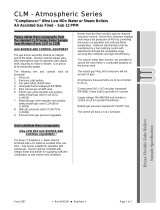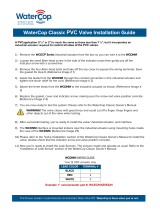
Benchmark 1500 - 2000 Boilers
Installation, Operation & Maintenance Manual (IOMM)
Page 4 of 188 AERCO International, Inc. • 100 Oritani Dr. • Blauvelt, NY 10913 OMM-0097_0D
Ph.: 800-526-0288 GF-142
3.5 SETUP MENU ....................................................................................................................................... 39
3.6 CONFIGURATION MENU .................................................................................................................... 40
3.7 TUNING MENU ..................................................................................................................................... 42
3.8 COMBUSTION CAL MENU .................................................................................................................. 43
3.9 BST (BOILER SEQUENCING TECHNOLOGY) MENU ....................................................................... 43
3.10 START SEQUENCE ........................................................................................................................... 46
3.11 START/STOP LEVELS ....................................................................................................................... 50
CHAPTER 4. INITIAL START-UP .................................................................................................. 51
4.1 INITIAL START-UP REQUIREMENTS ................................................................................................. 51
4.2 TOOLS AND INSTRUMENTATION FOR COMBUSTION CALIBRATION .......................................... 51
4.2.1 Required Tools & Instrumentation ................................................................................................................. 52
4.2.2 Installing Gas Supply Manometer ................................................................................................................... 52
4.2.3 Accessing the Analyzer Probe Port ................................................................................................................. 53
4.3 NATURAL GAS COMBUSTION CALIBRATION .................................................................................. 54
4.4 REASSEMBLY ...................................................................................................................................... 60
4.5 OVER-TEMPERATURE LIMIT SWITCHES ......................................................................................... 61
4.5.1 Digital Alarm Switch Checks and Adjustments ............................................................................................... 61
CHAPTER 5. MODE OF OPERATION ........................................................................................... 63
5.1 INTRODUCTION ................................................................................................................................... 63
5.2 INDOOR/OUTDOOR RESET MODE ................................................................................................... 63
5.2.1 Reset Ratio ...................................................................................................................................................... 63
5.2.2 Building Reference Temperature .................................................................................................................... 63
5.2.3 Outdoor Air Temperature Sensor Installation ................................................................................................ 63
5.2.4 Indoor/Outdoor Startup ................................................................................................................................. 63
5.3 CONSTANT SETPOINT MODE ........................................................................................................... 64
5.3.1 Setting the Setpoint ........................................................................................................................................ 64
5.4 REMOTE SETPOINT MODES ............................................................................................................. 65
5.4.1 Remote Setpoint Field Wiring ......................................................................................................................... 65
5.4.2 Remote Setpoint Startup ................................................................................................................................ 66
5.5 DIRECT DRIVE MODES....................................................................................................................... 66
5.5.1 Direct Drive Field Wiring ................................................................................................................................. 67
5.5.2 Direct Drive Startup ........................................................................................................................................ 67
5.6 AERCO CONTROL SYSTEM (ACS) .................................................................................................... 67
5.6.1 ACS External Field Wiring................................................................................................................................ 67
5.6.2 ACS Setup and Startup .................................................................................................................................... 68
5.7 COMBINATION CONTROL SYSTEM (CCS) ....................................................................................... 68
5.7.1 Combination Control System Field Wiring ...................................................................................................... 69
5.7.2 Combination Control System Setup and Startup ............................................................................................ 69
CHAPTER 6. SAFETY DEVICE TESTING ..................................................................................... 71
6.1 TESTING OF SAFETY DEVICES ......................................................................................................... 71
6.2 LOW GAS PRESSURE FAULT TEST .................................................................................................. 72
6.3 HIGH GAS PRESSURE TEST ............................................................................................................. 73
6.4 LOW WATER LEVEL FAULT TEST ..................................................................................................... 74
6.5 WATER TEMPERATURE FAULT TEST .............................................................................................. 75
6.6 INTERLOCK TESTS ............................................................................................................................. 76
6.6.1 Remote Interlock Test..................................................................................................................................... 76
6.6.2 Delayed Interlock Test .................................................................................................................................... 76
6.7 FLAME FAULT TESTS ......................................................................................................................... 77
6.8 AIR FLOW FAULT TESTS .................................................................................................................... 79
6.8.1 Blower Proof Switch Test ................................................................................................................................ 79





















